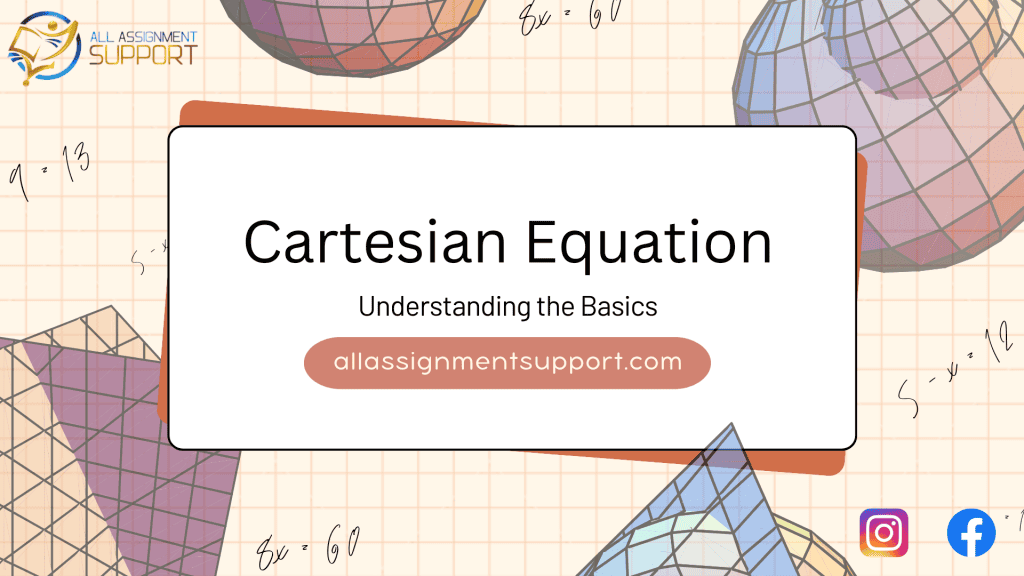Table of Contents
ToggleYou will need to find the Cartesian equation r=cosθ for the curve
Are you familiar with the following equation? Yes, of course. We’re talking about the Cartesian equation here. Nearly every student is tense when they hear “solve the Cartesian equation”. Moreover, it will create anxiety in their mind.
A common assignment for students pursuing maths is to write an essay on the Cartesian equation. Therefore, the issue arises when the students do not understand the basics of the Cartesian equation. Complex theories and the correct meaning of formulas pose great difficulty for them. When asked to do a challenging assignment on the Cartesian equation, they become terrified and start sweating from stress.
It will definitely help you if you are not sure how the Cartesian equation works.
Let’s take a closer look at the complex nature of the Cartesian equation in more detail.
Note: Are you facing any issues in Cartesian equations? Contact our best experts now to get your problems solved quickly.
An overview of the history of Cartesian equations
Rene Descartes was a powerful French philosopher, mathematician, and logic philosopher who coined Cartesian in 1637. Pierre de Fermat autonomously discovered it. He had previously worked in three scopes. However, Fermat has not credited its discovery to him. During Fermat and Descartes’ time, Nicole Oresme, a Fermic cleric, used structures similar to Cartesian cooperation. And this equation was very helpful. Cartesian systems became more common with the discovery of calculus by Gottfried Wilhelm Leibniz and Isaac Newton. There are two coordinates in the plane in the theory of vector spaces.
Cartesian Equation: What is it?
An equation of curvature or surface can be referred to as a Cartesian equation theoretically. The Cartesian coordinates of a position on a curve or surface are the variables. On the graph, the x-axis has one variable, and the y-axis has another. It is vital to understand the parametric equation before finding the Cartesian equation. As an example, if the parametric equation for y = 4t is given, you must divide both sides by 4 to get the Cartesian equation (1/4) y = t.
Cartesian equation: what is its purpose?
Cartesian equation
It has various applications in mathematics, such as algebra, geometry, calculus, and physics. Functions are important in mathematics. They help us define and study links between variables.
Some common examples of Cartesian equations
Example 1:
A parametric equation is responsible for the curve:
- x = 2 + t2; y = 4t
To understand the Cartesian equation of the curve, let us look at it.
- To assess the equation, solving the algebraic equations instantly is vital.
Divide both sides by 4 if y = 4t. You will get (1/4) y = t as a result.
With the equation for x, t changes its value.
- We obtain x = 2 + (1/4(y)) 2. After the bracket has been opened, the next step is to close it. It is crucial to square both 1/4 and y in order to obtain x = 2 + 1/16 y2.
Since the last equation contains variables x and y, it is in Cartesian form in theory. A rationalized extra equation can, however, be evaluated using the standard ‘y =’ format:
Alternatively, you can do the following:
- x = 2 + 1/16 y2 (subtract 2 from each side)
- x – 2 = 1/16 y2 (multiply each side by 16)
- 16x – 32 = y2 (take the square root of both sides)
- y = SQRT (16x-32)
Example 2:
It is likely to write the formula of a circle whose centre is at (2, 3) and the radius is 4 as follows:
- (x – 2)^2 + (y – 3)^2 = 16
An equation like this defines a circle’s coordinates by x and y. The formula (x – 2)^2 is for the length squared between the x-coordinate of a point on the circle and the x-coordinate of the midpoint of the circle.
Similarly, (y-3) ^ 2 means the square of the distance between the y-coordinate of a spot on a circle and the y-coordinate of its centre.
To get the circle’s point, add these two distances.
Dimensions of the Cartesian Equation
To have a complete idea of a Cartesian Equation, it is essential to understand its dimensions. A Cartesian Equation has many dimensions. They are categorized as:
One Dimension
Choosing a Cartesian coordinate system is suitable for a straight line in a one-dimensional space. The process involves the selection of a point O from the origin, a unit of length, and an orientation for the line. Orientation determines which of the two lines is positive or negative based on the two lines that are determined by O.
The number line is a line that is chosen with the Cartesian system. Real numbers have particular locations on the line, and all numbers are based on real numbers. For example, each point in the line can be viewed as a number within a well-organized range.
Two Dimension
In two dimensions or axes, a Cartesian coordinate system consists of the following items:
- An arrangement of two perpendicular lines
- Two distinct measures of length
- The orientation of the two axes
An origin of origin refers to the point at which two axes meet. As a result, every axis becomes a number line. Different names refer to coordinates and meeting points of the axes. For example, two coordinates are called abscissa, while the ordinate is called P. Similarly, the point at which the axes meet is known as the origin of the coordinate system.
It is common to note two distinct numbers for the two coordinates. A comma separates each case. Hence, the coordinate origin is (0, 0), and the positive and negative axes are one unit apart. Their coordinates are (0, 0) and (0, 1).
Three Dimensions
In three-dimensional space, the Cartesian coordinate system consists of the following elements:
- It is a set of three lines arranged around an origin or a common point.
- Lines perpendicular to each other
- Orientations for each line
- For all three axes, a single measure of length is used
There is a number line on every axis. Hyperplanes pass perpendicular to coordinate axes at point P in space. This shows where the hyperplane crosses the axis. There is a number next to it. These three numbers indicate the Cartesian coordinates of the point P.
The coordinates of a point P can be considered distances from P to the hyperplane defined by the other two axes. Depending on the orientation of the parallel axis, the numbers are accompanied by signs.
The formula of the Cartesian Equation
Three-dimensional Cartesian equations show the links between variables x, y, and z. Therefore, it is like this:
Ax + By + Cz + D = 0
Assume that A, B, C, and D are constants.
Here is the Cartesian equation formula for straight lines in two dimensions:
y = mx + c
In this case, m shows the gradient of the line, and c represents the intercept of y.
An illustration of a Cartesian equation
The following example illustrates the Cartesian Equation.
Five Easy Steps To Convert Polar Equation To Cartesian Equation?
Step 1)
Determine the polar equation’s pole and polar radius.
In polar radii, the pole is the fixed point to measure. In most cases, this is the origin (0, 0).
A curve’s polar radius (r) represents the distance from its pole to any point along its length.
For instance, in the equation r = 3sinθ, the pole is (0, 0), and the polar radius is r = 3sinθ.
Step 2)
Describe the polar radius in terms of x and y.
To use the conversion relationships, follow these steps:
x = rcosθ y = rsinθ
Then Substitute r in the equation.
For example, r = 3sinθ becomes:
x = 3sinθcosθ y = 3sinθsinθ
Step 3)
Substitute 1 for cos2θ + sin2θ.
It is possible to simplify Step 2 equations using this trigonometric identity.
Take the following example as an example:
x = 3sinθcosθ y = 3sinθsinθ
Becomes:
x = 3sinθcosθ y = 3sinθsinθ cos2θ + sin2θ = 1
Step 4)
Using algebraic manipulation, simplify the equations.
When possible, expand, factorize, or reduce terms.
We obtain the following results from the example equation:
x = 3sinθcosθ y = 3sinθsinθ x2 + y2 = 9sin2θ
Step 5)
Here is a simplified Cartesian equation.
For the final Cartesian equation, eliminate theta and combine variables.
To conclude the example, we have the following equation:
x2 + y2 = 9y2
Or, y2 = 3×2
This has been converted into a Cartesian equivalent of the polar equation.
Cartesian equation examples
There are several real-world applications for converting polar equations to Cartesian equations. Examples include the following:
Physics and engineering:
Polar coordinates in engineering and physics are commonly used to describe the motion of objects along circular paths or in systems with rotational symmetry. In addition to simplifying calculations, converting polar equations to Cartesian equations facilitates a better understanding of the dynamic properties of the system.
Radar Systems:
A radar’s plan position indicator uses polar coordinates to find the position and movement of objects within its field of view. Tracking and locating objects is more accurate by converting polar coordinates into Cartesian coordinates.
Robotics in industry:
Industrial robots use a system of coordinates to determine where and how their arms move. Industrial robots can also be guided using polar coordinates. This is mainly useful when the motion involves circular paths or rotations.
Gravitational Fields:
Gravitational fields are described using polar coordinates. Analyzing and understanding gravitational field behavior is made easier by converting polar equations to Cartesian equations
Electrical and Magnetic Fields:
It is necessary to use polar coordinates in order to calculate electric and magnetic fields. Mathematicians and physicists can simplify calculations and better understand these fields by converting polar equations to Cartesian equations.
These are just a few examples of how polar equations can be converted to Cartesian equations in real-world scenarios. In order to gain a better understanding of a wide range of phenomena, it is necessary to be able to switch between coordinate systems.
Read Also: Mathematics Assignment Help
The art of mastering Cartesian equations
Learning the concepts is the first step toward mastering working efficiently with Cartesian equations.
- Using a graph sheet, practice drawing lines, parabolas, circles, and regions manually. Learn how the shapes are affected by changing the parameters.
- You should be familiar with coordinate geometry and the Cartesian plane. Understand concepts such as slopes, distance formulas, and midpoint formulas.
- From the equations, learn how to find focuses, vertices, points of intersection, etc.
- Identify geometric descriptions and translate them into Cartesian equations.
- The shapes represented by the equations can be visualized using online graphing tools and apps.
- It is best, to begin with simple equations. Make progress by addressing equations of higher degrees and compound inequalities.
- Improve your conceptual understanding of equations and inequalities by solving them algebraically after graphing them.
- Learn how changing inequality signs can flip regions across boundary lines.
- Utilize Cartesian equations to solve real-world physics problems.
- Examine equation terms about graphical trends.
Practicing Cartesian equations regularly will make them second nature. A seamless transition between the algebraic and graphical forms will be possible. It is possible to apply this versatile mathematical tool to an array of exciting applications by mastering it.
Final words
The discussion above provides a clear understanding of “what is a Cartesian equation? It uses algebraic expressions to represent geometric objects such as lines, circles, and curves. To express the equation, a Cartesian coordinate system needs to be defined. The coordinate system has two vertical axes, called x and y.
Contact All Assignment Support experts if you have difficulties solving Cartesian equations and need assistance. As a result of our expertise, we will solve your math-related issues within the given deadline and help you achieve high grades.
Cartesian equation-FAQS
Q1. What is a Cartesian equation?
A Cartesian equation is an equation that represents geometric shapes and curves on a plane using the Cartesian coordinate system. Using a 2D coordinate grid, it plots points and shapes based on algebra and geometry.
Q2. What are the key components of a Cartesian equation?
There are several key components to consider:
- In this case, x and y represent the coordinates
- There are constants and coefficients associated with x and y
- Using operators such as powers, roots, trigonometric identities, etc.
- Relation symbols like =, <, >, ≤, ≥ representing curves, boundaries and regions
Q3. How do you graph a Cartesian equation?
- Put key points on the plot by substituting values of x or y
- In order to obtain a curve, connect the points and extend them
- Analyze asymptotes, intersections, maxima/minima, etc.
- For inequalities, shade regions
- Use graphing software such as Demos when necessary
Q6. What are the applications of Cartesian equations?
- Modeling geometrical shapes
- Visualizing real-life data
- Game design and computer graphics
- GPS and navigation systems
- Engineering concepts and physics
- Forecasting in economics and finance











